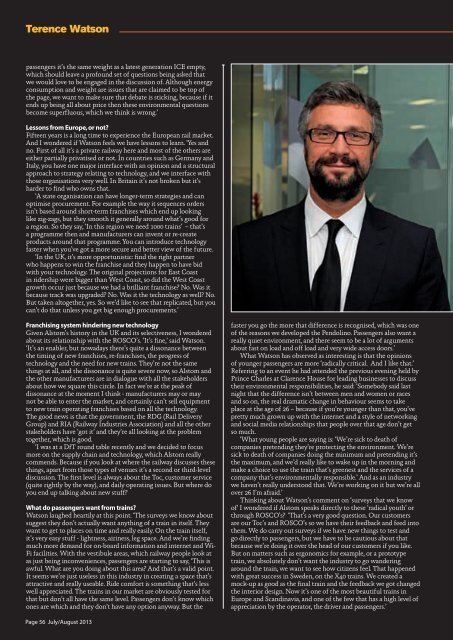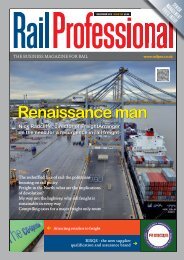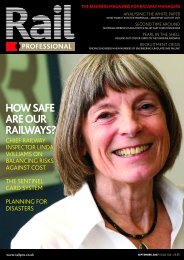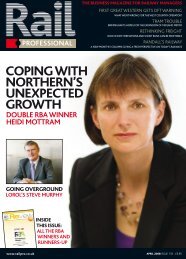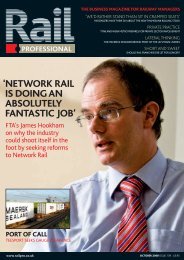View as PDF - Rail Professional
View as PDF - Rail Professional
View as PDF - Rail Professional
You also want an ePaper? Increase the reach of your titles
YUMPU automatically turns print PDFs into web optimized ePapers that Google loves.
Terence Watson<br />
p<strong>as</strong>sengers it’s the same weight <strong>as</strong> a latest generation ICE empty,<br />
which should leave a profound set of questions being <strong>as</strong>ked that<br />
we would love to be engaged in the discussion of. Although energy<br />
consumption and weight are issues that are claimed to be top of<br />
the page, we want to make sure that debate is sticking, because if it<br />
ends up being all about price then these environmental questions<br />
become superfluous, which we think is wrong.’<br />
Lessons from Europe, or not<br />
Fifteen years is a long time to experience the European rail market.<br />
And I wondered if Watson feels we have lessons to learn. ‘Yes and<br />
no. First of all it’s a private railway here and most of the others are<br />
either partially privatised or not. In countries such <strong>as</strong> Germany and<br />
Italy, you have one major interface with an opinion and a structural<br />
approach to strategy relating to technology, and we interface with<br />
those organisations very well. In Britain it’s not broken but it’s<br />
harder to find who owns that.<br />
‘A state organisation can have longer-term strategies and can<br />
optimise procurement. For example the way it sequences orders<br />
isn’t b<strong>as</strong>ed around short-term franchises which end up looking<br />
like zig-zags, but they smooth it generally around what’s good for<br />
a region. So they say, ‘In this region we need 1000 trains’ – that’s<br />
a programme then and manufacturers can invent or re-create<br />
products around that programme. You can introduce technology<br />
f<strong>as</strong>ter when you’ve got a more secure and better view of the future.<br />
‘In the UK, it’s more opportunistic: find the right partner<br />
who happens to win the franchise and they happen to have bid<br />
with your technology. The original projections for E<strong>as</strong>t Co<strong>as</strong>t<br />
in ridership were bigger than West Co<strong>as</strong>t, so did the West Co<strong>as</strong>t<br />
growth occur just because we had a brilliant franchise No. W<strong>as</strong> it<br />
because track w<strong>as</strong> upgraded No. W<strong>as</strong> it the technology <strong>as</strong> well No.<br />
But taken altogether, yes. So we’d like to see that replicated, but you<br />
can’t do that unless you get big enough procurements.’<br />
Franchising system hindering new technology<br />
Given Alstom’s history in the UK and its selectiveness, I wondered<br />
about its relationship with the ROSCO’s. ‘It’s fine,’ said Watson.<br />
‘It’s an enabler, but nowadays there’s quite a dissonance between<br />
the timing of new franchises, re-franchises, the progress of<br />
technology and the need for new trains. They’re not the same<br />
things at all, and the dissonance is quite severe now, so Alstom and<br />
the other manufacturers are in dialogue with all the stakeholders<br />
about how we square this circle. In fact we’re at the peak of<br />
dissonance at the moment I think - manufacturers may or may<br />
not be able to enter the market, and certainly can’t sell equipment<br />
to new train operating franchises b<strong>as</strong>ed on all the technology.<br />
The good news is that the government, the RDG (<strong>Rail</strong> Delivery<br />
Group) and RIA (<strong>Rail</strong>way Industries Association) and all the other<br />
stakeholders have ‘got it’ and they’re all looking at the problem<br />
together, which is good.<br />
‘I w<strong>as</strong> at a DfT round table recently and we decided to focus<br />
more on the supply chain and technology, which Alstom really<br />
commends. Because if you look at where the railway discusses these<br />
things, apart from those types of venues it’s a second or third-level<br />
discussion. The first level is always about the Toc, customer service<br />
(quite rightly by the way), and daily operating issues. But where do<br />
you end up talking about new stuff<br />
What do p<strong>as</strong>sengers want from trains<br />
Watson laughed heartily at this point. ‘The surveys we know about<br />
suggest they don’t actually want anything of a train in itself. They<br />
want to get to places on time and really e<strong>as</strong>ily. On the train itself,<br />
it’s very e<strong>as</strong>y stuff - lightness, airiness, leg space. And we’re finding<br />
much more demand for on-board information and internet and Wi-<br />
Fi facilities. With the vestibule are<strong>as</strong>, which railway people look at<br />
<strong>as</strong> just being inconveniences, p<strong>as</strong>sengers are starting to say, ‘This is<br />
awful. What are you doing about this area And that’s a valid point.<br />
It seems we’re just useless in this industry in creating a space that’s<br />
attractive and really useable. Ride comfort is something that’s less<br />
well appreciated. The trains in our market are obviously tested for<br />
that but don’t all have the same level. P<strong>as</strong>sengers don’t know which<br />
ones are which and they don’t have any option anyway. But the<br />
f<strong>as</strong>ter you go the more that difference is recognised, which w<strong>as</strong> one<br />
of the re<strong>as</strong>ons we developed the Pendolino. P<strong>as</strong>sengers also want a<br />
really quiet environment, and there seem to be a lot of arguments<br />
about f<strong>as</strong>t on load and off load and very wide access doors.’<br />
What Watson h<strong>as</strong> observed <strong>as</strong> interesting is that the opinions<br />
of younger p<strong>as</strong>sengers are more ‘radically critical. And I like that.’<br />
Referring to an event he had attended the previous evening held by<br />
Prince Charles at Clarence House for leading businesses to discuss<br />
their environmental responsibilities, he said: ‘Somebody said l<strong>as</strong>t<br />
night that the difference isn’t between men and women or races<br />
and so on, the real dramatic change in behaviour seems to take<br />
place at the age of 26 – because if you’re younger than that, you’ve<br />
pretty much grown up with the internet and a style of networking<br />
and social media relationships that people over that age don’t get<br />
so much.<br />
‘What young people are saying is: ‘We’re sick to death of<br />
companies pretending they’re protecting the environment. We’re<br />
sick to death of companies doing the minimum and pretending it’s<br />
the maximum, and we’d really like to wake up in the morning and<br />
make a choice to use the train that’s greenest and the services of a<br />
company that’s environmentally responsible.’ And <strong>as</strong> an industry<br />
we haven’t really understood that. We’re working on it but we’re all<br />
over 26 I’m afraid.’<br />
Thinking about Watson’s comment on ‘surveys that we know<br />
of’ I wondered if Alstom speaks directly to these ‘radical youth’ or<br />
through ROSCO’s ‘That’s a very good question. Our customers<br />
are our Toc’s and ROSCO’s so we have their feedback and feed into<br />
them. We do carry out surveys if we have new things to test and<br />
go directly to p<strong>as</strong>sengers, but we have to be cautious about that<br />
because we’re doing it over the head of our customers if you like.<br />
But on matters such <strong>as</strong> ergonomics for example, or a prototype<br />
train, we absolutely don’t want the industry to go wandering<br />
around the train, we want to see how citizens feel. That happened<br />
with great success in Sweden, on the X40 trains. We created a<br />
mock-up <strong>as</strong> good <strong>as</strong> the final train and the feedback we got changed<br />
the interior design. Now it’s one of the most beautiful trains in<br />
Europe and Scandinavia, and one of the few that h<strong>as</strong> a high level of<br />
appreciation by the operator, the driver and p<strong>as</strong>sengers.’<br />
Page 56 July/August 2013


